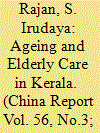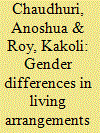|
|
|
Sort Order |
|
|
|
Items / Page
|
|
|
|
|
|
|
| Srl | Item |
| 1 |
ID:
174699


|
|
|
|
|
| Summary/Abstract |
This article presents an overview of the elderly in Kerala and describes various dimensions of elderly care and concerns, based on data from the Kerala Ageing Survey (KAS) 2013, conducted by the Centre for Development Studies (CDS), Thiruvananthapuram, Kerala. The article looks into the main issues, policies and programmes related to ageing and elderly care practices in Kerala and also addresses the basic care response at three levels: household, institutional and society. The ageing process in Kerala is witnessing an increase in the ratio of elderly population along with fundamental changes in families and communities. Hence, in order to accommodate the needs of the ageing population in society, various systems need to be reconstructed. The concerns and issues surrounding the ageing population requires long-term attentiveness and forward planning, where policies must be adopted with consideration for cultural and social contexts. Care for the elderly should focus on a holistic combination of health care, socio-economic protection and provision of a suitable environment for better quality of life.
|
|
|
|
|
|
|
|
|
|
|
|
|
|
|
|
| 2 |
ID:
089757


|
|
|
|
|
| Publication |
2009.
|
| Summary/Abstract |
This article uses the 52nd round of National Sample Survey data to examine gender differences in living arrangement choices of the elderly in India. Older women are more likely to live alone than older men, even after controlling for demographics, socioeconomic characteristics, health status, economic independence and property ownership. Economic independence is associated with higher likelihood of living alone for men and women. While physical immobility decreases the likelihood of living with children or extended family for older men, older and physically immobile women are less likely to live alone if they have sons rather than daughters.
|
|
|
|
|
|
|
|
|
|
|
|
|
|
|
|
| 3 |
ID:
147417


|
|
|
|
|
| Summary/Abstract |
Migration of any distance separates family members for long periods of time. In China, institutional legacies continue to privilege the migration of working-age individuals who often leave children and elders behind in the rural areas. Up to now, the literature has treated children and elders analogously, labeling each group as “left-behind.” We argue that analysis of elder stayers needs to be more nuanced, distinguishing among differing groups of elders. Of these groups, those living alone without any adult children in the village are most at risk, while those living with other non-migrant adult children are much less affected by migration. Another group of elders, clearly affected by migration, are those caring for their grandchildren while the children's parents have migrated. Members of this latter group need to be distinguished from those living alone as they are dissimilar in many fundamental ways (age, working status, marital status) and face a very different set of challenges from those left behind (perhaps frail) and alone.
|
|
|
|
|
|
|
|
|
|
|
|
|
|
|
|
|
|
|
|
|